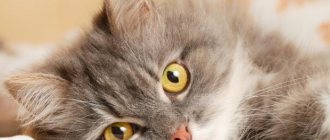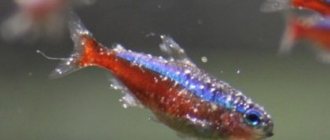Both Djungarians, Syrians, and any other types of hamsters sometimes suffer from diseases. Among them there are those that are transmitted to humans and pose a danger to them. In short, you will read everything you need to know about diseases of Syrian hamsters in this article. This is necessary to know not only for owners of Syrians, but also for those who are just planning to get a hamster.
Friends, I apologize in advance, but the photos in this article will be kept to a minimum. Looking at sick animals is not the most pleasant experience. Perhaps there are more visual and detailed photographs on specialized veterinary websites, but please do not forget that our articles are also read by children. It’s too early for them to consider this.
Classification of diseases
Hamster diseases can be classified according to various indicators. For example, depending on where the pain occurs, it can be gastrointestinal, skin, associated with the respiratory system, limb injuries, etc. There are also congenital (genetic) and acquired ailments. But most often the classification is based on the factor that causes the disease.
The following causes of hamster diseases are identified:
- Bacteria. They cause skin lesions, inflammation, gastrointestinal problems, and eye diseases.
- Viruses. They provoke the development of tumors and pathologies of the nervous system.
- Microscopic fungi. Affects the skin.
- Metabolic disease. The most striking example is diabetes mellitus in Djungarian hamsters.
- Stress factors. They affect not only the emotional state of the animals, but also the skin and condition of the fur.
When keeping animals at home, dislocations, fractures, and bruises caused by falls sometimes occur. They are characterized by severe pain and swelling.
Medicines for diseases in hamsters
Remember that a number of medications are dangerous for hamsters, and their use can lead to death. Antibiotics dangerous for hamsters include:
- penicillin
- ampicillin
- erythromycin
- gentamicin
- lincomycin
- cephalosporins
Never use an antibiotic without your doctor's advice.
To prevent any disease in hamsters, follow sanitary and hygienic rules, such as regular cleaning and disinfection of the cage, preventing contact with sources of disease, as well as adequate feeding and optimizing the hamster’s living conditions.
When to sound the alarm?
Few owners notice changes in the condition of their pets in the early stages of the disease. But early diagnosis is the key to a speedy recovery of the animal. How can you tell if your pet has health problems? Of course, conduct an external examination and observe the fluffy for a couple of days. You should:
- assess the animal’s activity: if Homa suddenly becomes lethargic, he is clearly unwell;
- watch your appetite. Healthy animals love to snack. If a pet refuses even its favorite treat, it is seriously ill;
- check the weight. An adult Syrian hamster must weigh at least 90 g; for all other breeds, including Djungarian hamsters, the weight must not be less than 30 g;
- examine your pet's face. The eyes should be shiny, without cloudiness or mucus. Nose – cool, without discharge. Check your ears for flaking. Pay attention to the incisors: they should grow evenly;
- make sure that there are no skin growths or tumors on the neck, armpits and abdomen;
- inspect the butt and the area of fur under the tail, they should not be wet or dirty;
- the living space also needs to be examined: if the rodent has an intestinal disorder, the stool will be liquid, and if it has cystitis or diabetes, you will understand it by the smell.
If at least one sign is detected, it is worth taking the fluffy to the veterinarian so that he can make a diagnosis and prescribe treatment.
Constipation in rodents
Constipation, that is, a prolonged absence of stool, is most often provoked by a lack of water and moisture in the diet. In addition, among the reasons may be intestinal obstruction or the predominance of dry roughage in the diet.
Constipation symptoms:
- The amount of excrement in the cage has become significantly smaller
- The droppings on the floor are small, too hard and even dry, reminiscent of small black dots
- If a rodent is constipated, its posture changes and it begins to stoop.
- Among the local signs, it can be noted that abundant moisture appears near the butt, which was not there before.
To help the animal, it is necessary to adjust food and drink; the rodent must have constant unhindered access to water. In addition, it is worth adding vegetables and fruits to your diet or increasing their share in the diet. An excellent method of combating constipation is regular vegetable oil; just one drop on an empty stomach can establish normal bowel function. If these measures do not help the next day, then you need to take your rodent to see a veterinarian.
Bacterial infections
Fluffies are the most susceptible to bacterial diseases. They can be picked up from another animal, from stale food, or directly from the cage if it is not cleaned for a long time. Let's look at their types, symptoms and treatment.
By the way, some ailments caused by bacteria can be transmitted to animals from humans and vice versa!
Tuberculosis
The reason is the proliferation of tuberculosis bacilli in the intestines or respiratory tract, respectively, and the forms of the disease are intestinal and pulmonary. The routes of entry of pathogenic microorganisms are airborne droplets, less often with food.
The disease causes shortness of breath, a significant decrease in appetite, which leads to complete exhaustion of the body. In the pulmonary form, animals experience a cough, and in the intestinal form, severe diarrhea occurs. At the last stage, the fluffy's eyes become cloudy. Due to the fact that tuberculosis in rodents is incurable, it is more humane to euthanize the homa.
To prevent your pet from picking up this infection, the cage should be kept clean and the dairy and meat products included in the hamster’s diet should be cooked. You should also limit the animal’s interaction with infected people and other rodents.
Colibacillosis
A dangerous infection caused by an increased content of E. coli in the digestive tract. The disease is very contagious, so if hamsters are kept together, tests will have to be taken from all of them, and all of them will have to be treated together.
This hamster disease is also called “wet tail” because the main symptom is severe diarrhea. But at the initial stage the following are noted:
- decreased appetite;
- weight loss;
- lethargy;
- restless behavior;
- trying to curl up into a ball;
- wet fur on the butt.
If you have severe diarrhea, your hamster's stool will look more like urine. This explains why the hamster is wet but not dirty.
If you find these signs in your furry, consult a doctor who will tell you how to treat colibacillosis. Veterinarians typically prescribe tetracycline medications as a supplement to water and food, or (in rare cases) chloramphenicol injections.
It is possible to cure the animal only in the early stages of the development of the disease. A preventive measure is to keep animals in separate cages and clean them up more often.
Cystitis
A very unpleasant disease of Djungarian hamsters and Syrians. The urinary system suffers. At the same time, the hamster has pain in the lower abdomen, he experiences severe pain and a burning sensation when urinating. The animal loses a lot of water and is constantly thirsty. This disease appears after hypothermia of the body, which can even be caused by a fan!
Cystitis is treated with antibiotics. The main thing is to make the correct diagnosis, because the disease can be confused with colibacillosis. Both of these sores can answer the question “why does a hamster have wet fur?”
Prevention. Make sure that your pet does not become overcooled; do not place the cage near an open window.
Diplococcosis
A respiratory tract infection caused by round bacteria called diplococci. Common symptoms are lethargy and weakness. The animal is trembling slightly and his nose is running. Sometimes the animal may stop paying attention to food.
It is treated with a special serum, which should be administered as early as possible, since diplococcosis can take the life of a pet in 2-3 days.
Salmonellosis
Acute intestinal sore. It is provoked by salmonella bacilli. In addition to general lethargy and the desire to hide in a dark corner, foamy diarrhea and light green discharge, possibly with blood, are observed. Often the animal's tummy is swollen, the temperature fluctuates from very low to abnormally high.
Salmonellosis can kill an animal in 2 days, so emergency diagnosis and treatment are necessary!
Pneumonia
Develops due to increased activity of pneumococci against the background of a general weakening of the immune system. Usually occurs after severe hypothermia and due to a lack of vitamins in the rodent’s body.
Symptoms of this disease in hamsters are:
- lethargy, inactivity;
- lack of appetite;
- wheezing and cough;
- mucous discharge from the nose.
Pneumonia is often accompanied by eye sores. Most often this is conjunctivitis.
The disease is not dangerous: with a course of vitamins and antibiotics, the animal recovers completely within a week.
Conjunctivitis
Eye disease. Symptoms include heaviness and a feeling of glued eyelids. The most common cause is a cold, but some bacteria can also cause it. It is necessary to rinse your pet's eyes with salted water and use drops prescribed by your veterinarian.
There are a great many diseases and not a single article is enough to describe them all. Yes, this is not necessary. The main thing is to notice the symptoms in time that something has happened to your pet. And then, if possible, immediately go to the veterinary clinic. The best person to help your pet is a doctor. After all, there they will conduct the necessary tests for you, accurately diagnose you, and prescribe effective pills.
Endometritis
A disease characteristic of females. At its core, it is an inflammation of the uterus and appendages caused by streptococci. The disease occurs with frequent sexual intercourse and childbirth. The only chance to save the pet is to take it to surgery.
Oral inflammation
It usually starts on the inside of the cheeks. In wounds from hard foods, various bacteria develop, causing an inflammatory process. The hamster may develop swelling on its face.
This sore is very unpleasant, but not dangerous. The doctor carefully turns out the pet’s cheeks, removes the remains of rotting food from the wounds and treats them with bactericidal ointments and solutions. After two days, the homa will no longer feel discomfort. The main thing is not to feed the animal for the first 12 hours after cleaning.
And as a preventive measure, make sure that the animal’s food meets the requirements: it is not too hard and does not contain sharp jagged edges.
The listed bacterial infections plague rodents more often than others. Homa can also contract tularemia and listeriosis, but they are much less common.
Oral and dental diseases
Hamsters, like any rodents, grow their incisors throughout their lives, so owners should pay special attention to oral hygiene and the animals' teeth. If the pet does not grind down its teeth, this will lead to injury, damage to the oral mucosa, the development of acute inflammation, the formation of abscesses, and abscesses.
Pathologies and dental diseases in Djungarians and Syrians are manifested by redness of the mucous membranes, hypersalivation, decreased appetite, weight loss, abnormal growth, deformation of the incisors, and inflammation of the cheek pouches.
Inflammation of the cheek pouches is one of the most commonly diagnosed pathologies. It is characterized by inflammation, prolapse (prolapse), and the appearance of pathological formations. The disease develops due to injury to the oral mucosa. With this pathology, the animals behave restlessly, rubbing their cheeks and muzzle with their paws. Appetite decreases. Saliva flows from the mouth. As a rule, the pathological process affects the inner surface of the cheeks.
Long incisors provoke dental diseases in hamsters
To relieve inflammation, you need to rinse your pet’s mouth with an antiseptic solution or chamomile decoction. To normalize digestion, give your hamster probiotics and enzymes.
For neoplasms, surgical treatment, restorative, and symptomatic medications are prescribed.
If your hamster has inflamed cheek pouches, treatment should be carried out by a veterinarian. The specialist will carefully turn out the cheeks and clean them of food debris. Inflammation will be relieved by bactericidal drugs, antiseptics, and medications for local and general treatment. After therapy, the hamster must be kept on a fasting diet for 12–14 hours.
Viral diseases
Hamsters, like many other mammals, are susceptible to viral attacks. It is harder for tiny creatures to fight viruses, because their immunity is extremely fragile.
Common viral illnesses are:
- Lymphocytic choriomeningitis. It can be transmitted from a sick hamster to its cubs. Expressed in weakness of the body, sudden weight loss. Choriomeningitis can be treated in the early stages, and it is necessary to treat the animal, because its disease can be transmitted to its owners!
- False rabies (Aujeszky's disease). The nervous system suffers. The behavior of a sick animal is characterized by increased restlessness; it twitches and constantly tries to scratch itself. In order for the pet to recover, a special serum is injected into it. In advanced cases, paralysis and death occur.
- Respiratory infections. Few people know that hamsters can develop acute respiratory infections, but this is true. Viruses actively attack the fluffy’s weak body, and as a result, the homa may die. There are no specific antiviral drugs for hamsters, so you should take care of their immunity by giving enough fresh vegetables and herbs. If your pet has a cold, he must cope with the disease himself, without medication.
- Tumors. There are types of viruses that can provoke the development of neoplasms. It is impossible to cure such illnesses.
Viral infections are difficult to fight, so prevention is important. You should think over the diet of rodents and give them food containing vitamins.
Main diseases and their causes
Hamsters are susceptible not only to specific diseases that are characteristic of this particular type of rodent, for example, inflammation of the cheek pouch, but can also be infected with viruses, bacteria, and parasites. It is worth noting that most diseases of Syrian and Djungarian hamsters most often occur due to the fault of the owners. Thus, drafts can provoke colds, and an unbalanced diet leads to the development of hypo- and vitamin deficiencies, and can cause disruptions in the gastrointestinal tract and endocrine pathologies. Deficiency of vitamins, minerals, amino acids, and poor-quality feed weaken the animals’ immune potential and resistance.
Predisposing factors that can cause diseases in hamsters include:
- poor-quality diet with poor nutritional ratios;
- poor living conditions (cramped, dirty cage);
- unsuitable indoor microclimate;
- frequent stress, fear, emotional stress;
- improper care of pets.
Hamsters are susceptible to injury and often suffer from metabolic disorders and digestive processes in the body. Dzungarians and Syrians suffer from viral, bacterial, parasitic diseases, as well as non-communicable diseases. Tumors, neoplasms, and allergic manifestations (dermatitis, dermatoses) are often detected in hamsters.
Hypovitaminosis
Important! An improperly equipped cage can lead to injury to a small pet, causing dislocations, sprains, and torn ligaments. When two or more hamsters are kept in one cage, the rodents will fight for territory in real hamster fights. Moreover, such battles can often cause the death of babies or weaker individuals.
Common diseases of Djungarian and Syrian hamsters:
- obesity, diabetes;
- inflammation of the cheek pouch;
- abscesses on the paws;
- mechanical injuries (dislocations, fractures, sprains);
- ophthalmological diseases (keratitis, conjunctivitis);
- respiratory diseases of various etiopathogenesis;
- viral-bacteriological, invasive diseases;
- dermatophytosis;
- dermatitis, dermatoses, mycoses;
- colibacillosis;
- helminthic infestations;
- tularemia;
- false rabies (Aujeszky's disease);
- lymphocytic choriomeningitis;
- dental diseases.
Note that some viral, bacterial infections, parasitic diseases of dwarf hamsters and Syrian hamsters are dangerous for people. A person can become infected with rabies, salmonellosis, tularemia, dermatomycosis, campylobacteriosis, and plague from a rodent.
Inflammation of the cheek pouches in a hamster
If you purchase hamsters in pet stores, from trusted breeders, create optimal living conditions for the pet, and do not neglect the rules of hygiene, many of the diseases that hamsters suffer from can be avoided.
Fungal infections
Fungi parasitize the skin epithelium of furry animals and can be located on the paws and ears. As a result, hamsters develop various sores, dandruff, and itchy skin on their bodies. If the problem is not solved in time, the animal will scratch itself into deep scratches, bacteria will settle in them and inflammatory and putrefactive processes will begin.
What do hamsters suffer from, what mycoses?
- Dermatophytosis. The skin peels off, ulcers appear, and the fur begins to come out. Dermatophytosis must be treated with special solutions (chlorhexidine, miramistin), ointments or shampoos, which must be prescribed by a veterinarian.
- Lichen. In areas that have lost hair, fresh wounds and drying crusts are visible. The disease is contagious, so do not keep a healthy hamster in the same cage as a sick one. The sore is diagnosed by scraping and treated with special creams and ointments. If the hamster has no wounds or peeling on the skin, but the hair has fallen out, then this is not lichen, but vitamin deficiency.
- Trichomonosis. A hamster can become infected with this parasite through dirty water or low-quality food. Young animals under the age of one year become ill more often. The symptom is unique and easy to recognize: a yellow tint to the throat from the inside. Over time, a swelling appears there, preventing the animal from breathing. To prevent infection, it is necessary to frequently disinfect the cage, monitor the quality of food and utensils, and the cleanliness of all objects with which the animal comes into contact.
What to do if your hamster is sick
What should you do if you notice one or more of the above signs?
- The first thing to do is to isolate the sick animal to avoid further spread of the disease among the hamsters and until the cause of the poor health is determined.
- In quarantine conditions, the rodent should be as cozy and comfortable as possible, eliminate noise and bright light; you need to observe the behavior of other hamsters; it is possible that symptoms of the disease will appear in them, but later
- The cage or aquarium in which the sick rodent lives must be thoroughly washed and disinfected, and the cage itself and everything that was in it must be washed
- Bedding should be replaced immediately as it may contain excrement from a sick animal.
In addition to all of the above, it is worth saying that experienced breeders recommend not to self-medicate and seek help from a veterinarian in a timely manner. It is important to do this not only in order to treat a sick hamster, but also in order to promptly detect diseases that are dangerous to humans, which can be transmitted by the most common pet hamster. Indeed, hamsters quite often suffer from illnesses that pose a danger to humans; this is especially scary if there are small children in the house.
The veterinarian, in turn, can prescribe any tests and medications aimed at speedy recovery of the pet. Another reason why you should turn to a professional for help in treatment is that hamsters quite often react painfully to taking certain drugs, so their prescription should be approached with full responsibility. During treatment, it is important to adhere to all the recommendations given to you, strictly follow the prescribed dosages and follow the schedule. Now let's move on to a description of the most common ailments and life-threatening conditions of hamsters, learn about what hamsters suffer from and what treatment should be for hamsters.
Metabolic disorders
Do you know what hamsters get sick with besides viral, fungal and cold infections? Some individuals experience metabolic disorders. Sometimes they are hereditary, but sometimes humans are also to blame, as is the case with diabetes mellitus among the Djungarians.
Diabetes
Interestingly, the symptoms of diabetes in hamsters are the same as in humans:
- irrepressible thirst and increased appetite;
- sharp fluctuations in weight (quickly losing weight or getting fat);
- physiological fluids smell like acetone (urine, saliva);
- increased interest in the wheel: the animal is able to spin it longer than usual without stopping.
Diabetes mellitus is diagnosed using a laboratory blood test - checking glucose levels. After the diagnosis is established, drug treatment and a diet with a high protein content and a small amount of “fast” carbohydrates are prescribed.
Stroke
Metabolic diseases also include vascular diseases that occur in old age. Stroke in hamsters is often caused by the deposition of cholesterol plaques in the vessels of the head (that is, lipid metabolism is impaired). When the plaque completely covers the lumen of the vessel, blood accumulates, and the walls of the vein or artery stretch under its pressure. But they cannot stretch forever, the vessel bursts and hemorrhage occurs.
Stone disease
Stone disease is a very dangerous condition for hamsters. It occurs when salt metabolism is disrupted, as a result, sand gradually accumulates in the kidneys, bladder and bile ducts, combining into pebbles. When the stone moves, it causes hellish pain, the hamster screams heart-rendingly. Also, with this disease, the hamster's tail is tucked, the animal rarely pees, and there is blood in the urine. In small rodents the disease is not treated.
Obesity
In nature, hamsters are in a state of perpetual motion. And in our home they are often deprived of many active activities. There is a particularly high risk of decreased activity due to obesity, which can lead to even more dire consequences. After all, obesity is the first path to cardiovascular diseases and muscle atrophy. To avoid problems, carefully monitor your pet’s diet and make sure that his cage has enough “horizontal bars” for exercise: a running wheel, ladders, free space, tunnels. Let the animal out for a free run more often, the main thing is to carefully ensure that it does not run anywhere and get hurt.
Obesity, like urolithiasis, is typical for mature hamsters. It occurs infrequently in active dwarf hamsters (unless accompanied by diabetes); Syrian hamsters have a greater predisposition.
The photo shows an obese hamster.
Polycystic ovary syndrome
Polycystic ovary syndrome is a hormonal disorder in hamsters. The main cause of hormonal imbalances is frequent childbirth. At the same time, the hamster becomes lethargic, irritable, and her tummy is slightly swollen, bowel movements are irregular. It is possible to cure a female, but it cannot be done without surgery.
Hormonal changes coupled with poor nutrition can cause hemorrhoids in a hamster. This is a painful condition in which it is painful for the animal to defecate; in the hamster, blood can be seen on the fur under the tail.
Excess weight
If your animal moves little, but does not suffer from a lack of appetite, then it faces a problem such as obesity. It is worth saying that this condition is fraught not only with a limitation of physical activity, but also can lead to the development of heart problems.
To prevent excess weight gain, you should wisely select your rodent’s diet and ensure that it is balanced and rich in vitamins. You also simply must install a wheel or ball in the cage, where physical exercises will take place regularly.
Diseases caused by stress
Many factors contribute to stress for furbabies. Among them are sharp sounds, persecution by the cat, poor care, poor nutrition, inattention or intrusiveness of the owners. All this disrupts the hamster’s mental balance and causes serious illnesses. Their treatment should first of all be aimed at eliminating stress factors, and then at eliminating symptoms.
What do hamsters get sick with when they are stressed?
- Eczema. In autumn, the skin becomes sensitive, it peels off, wounds and sores appear, the fur seems to fade before our eyes, becomes dry and hard.
- Baldness. The wool falls out in large clumps. A specific area may become bald, or there may be islands of skin devoid of hair. Most often it occurs due to the lack of the required amount of vitamins and microelements. However, it can also be caused by simply experiencing severe stress. Therefore, at the first suspicion, make sure your pet is comfortable and eating the right diet. Externally, the problem is similar to lichen, but the skin is smooth and does not have any defects. At first, the two ailments are absolutely identical, so at the first sign, run to the doctor and find out the root cause. In this situation, you cannot rely on chance or traditional methods; it is better to take the necessary tests and get an accurate diagnosis. After all, both diseases are dangerous for the animal.
- Paralysis and heart attack. A strong sudden fright may well cause cardiac arrest, partial or complete paralysis of the furry.
Many people don’t know what to do to stop their hamster getting sick. First of all, you should think: what doesn’t your pet like? Why is he uncomfortable? We suggest you study the tips on this issue:
- do not yell at your pet or hit it under any circumstances;
- do not allow other pets near the cage;
- Do taming only a few days after acquiring the furry;
- do not force the animal to play or eat;
- monitor your hamster's diet;
- place the cage in places where there are no drafts;
- remove noisy devices from the cage;
- Clean your hamster's house more often.
As you can see, the recommendations are the simplest. But they will provide the animal with peace of mind and will not allow it to get sick from stress.
As you can see, most hamster diseases are the result of unsanitary conditions, improper care and feeding. You have the power to make the life of a funny animal interesting and comfortable, and this will increase its chances of a long and happy life without disease.
Neoplasms
Without a doubt, these diseases are the most serious, and hamsters are quite susceptible to them. If you find a lump on an animal's body, you should be concerned. This is not necessarily cancer, it could also be mechanical damage. In order to find out the diagnosis, you need to consult a veterinarian.
One of the most common reasons for the death of hamsters is that the owners do not go to the veterinary clinic in a timely manner, because they are ashamed of the size of their pet and do not want to bother the veterinarians “over trifles.” This is the wrong approach to keeping your pet.
Nowadays, many veterinary clinics have veterinarians specializing specifically in diseases of rodents and providing assistance to them, including complex operations.
In order for your animal to feel good and live a long life, it is necessary to treat it in a timely manner and provide it with healthy and fresh food.
Dental problems
Like any other rodent, hamsters' front teeth are in a state of perpetual growth. However, too fast a pace can cause pain and inconvenience to the animal, because it does not have time to grind them down. Sometimes a bad bite leads to pain in the mouth. Such defects are common and often inherited. It can be noticed by increased salivation and refusal even of favorite treats. It is best to take your pet to a veterinarian, as only he can determine the exact cause and prescribe effective treatment.
Eye diseases and their treatment
Small animals often suffer from ophthalmological diseases. Allergic, serous, purulent conjunctivitis, cataracts, glaucoma, and uveitis are noted in hamsters. In these diseases, blepharospasm, lacrimation, swelling, swelling, and sticking of the eyelids are observed.
Treatment should begin immediately as soon as you notice the first symptoms. Do not forget that eye diseases can provoke not only a deterioration in visual function, but also cause complete or partial blindness.
Conjunctivitis
In medical therapy, the choice of methods depends on the stage, nature of the disease, and the root cause. Solutions for washing the eyes and ophthalmic drops may be prescribed.
Inflammation of the pouches
The inside of the cheek pouch can be easily damaged by a sharp object. Since the hamster uses it constantly, pieces of food will get into the wound, which will further aggravate the situation. If you suspect, take your baby to the vet. He examines the animal, turning the bags outward. Under no circumstances try to do this yourself: there is a high risk of harming your pet even more. Such wounds are cleaned with conventional bactericidal agents, but first you need to remove food debris from them with special tweezers.
Disorders of the gastrointestinal tract
It is quite easy to determine deviations in the functioning of the gastrointestinal tract, since they are accompanied by:
- Diarrhea.
- Strong unpleasant odor.
- Rumbling sounds in the stomach.
If these symptoms occur, you must immediately put the animal on a diet.
Under no circumstances should you use medications intended for treating humans, since the human body and the hamster are very different.
If symptoms persist for several days even if the pet is on a diet, you must contact a veterinarian, otherwise the hamster will die.
Habitats and how to arrange a cage. Diseases of Djungarian hamsters
Since some people keep Djungarian hamsters as a pet, their habitat is a cage or a specially equipped terrarium with oxygen supply. Thus, a person can easily track the life cycle of animals. There should be no high structures in cages and terrariums
.
These animals are so agile that they are sometimes clumsy, and this can cause further injury, for example, if they fall from a height. If a hamster falls, it can get bruises or scratches
, which in turn can worsen, leading to more serious consequences. Close observation with due attention to the hamsters will give you the opportunity to promptly notice any deviations from the usual norm.
Let's together highlight some important aspects when arranging the future home of the Djungarian hamster
. The cage should contain a sippy cup, feeders, a house and wheels for games, since these animals, as mentioned earlier, are very mobile. The presence of stairs, tunnels and other household items at your request. Some people arrange the presence of two furious elevations in the cage.
These animals are not very endowed with the instinct of self-preservation by nature; only the close attention of their owners, as well as care for such a cute creature, will help prolong the life of the animal. If you once came up with the idea of getting a Djungarian hamster and you think that you will have no problems coping with such a small creature, then you are mistaken. Before getting an animal, it is worth talking with knowledgeable people who have experience in handling such animals. If you decide to give a gift to a child, then you should give a gentle lecture on handling and care. Any animal in the house is a great responsibility for their owners. The lecture will help you prevent your child from further disappointment.
What do Djungarian hamsters get sick of?
Due to such characteristics of the Djungarian body as a fast metabolism, fragile nervous system and genetic predispositions, they often get sick and can be injured.
Did you know? The largest members of the hamster family are European hamsters, which can grow up to 34 cm in length.
Mechanical injuries
Mechanical injuries in the form of dislocations, fractures and bruises can happen to an animal due to a fall from a great height, as well as excessively strong manifestations of love from a person.
Signs of mechanical injuries:
- visually noticeable curvatures and deformations of the limbs;
- difficulties in movement;
- lethargic appearance;
- pain shock.
Treatment. Methods and means of treatment in such cases are determined by a veterinarian, who should be contacted immediately after the appearance of any of the symptoms. He will carefully examine the rodent, assess the severity of the injury and determine treatment options. During treatment, the wheel is removed from the cage so that the hamster cannot actively run. You can place the animal in an aquarium to limit its activity. Important! To help the bones heal faster, you need to add milk, soft bread or dog treats with calcium to the animal’s diet.
Prevention. You can protect your hamster from mechanical injuries by limiting his movements on high surfaces, keeping an eye on him during walks outside the cage, and also controlling your strength during manifestations of your love.
Obesity
Often pampering the animal with goodies, owners expose it to the danger of becoming obese.
Symptoms:
- low mobility;
- visually complete appearance;
- dyspnea.
Treatment. The first thing to do is to increase the activity of the rodent. He needs to buy a running wheel that he can run on every day. In the evening, when the animal’s activity is at a high level, you can let it run around on the sofa. You need to remove fatty foods and cereal grains from the animal’s diet. Important! Keep a close eye on your hamster when walking in open areas to make sure he doesn't fall and get injured.
Prevention. To keep your pet from getting fat, you need to ensure daily activity and feed your pet properly. Choose a balanced food for him, which contains many useful substances and add vegetables and fruits to it.
Bite disorders
Bite disorders occur due to the fact that the growth of teeth in Djungarians does not stop throughout their lives. Due to inappropriate nutrition, teeth wear down incorrectly, grow excessively and can injure the jaw and oral area.
Symptoms:
- the pet refuses to eat;
- thinness, bowel irregularities;
- abscesses and inflammation on the face;
- mucous discharge from the eyes and nose;
- excessive salivation (wet fur on the chin or chest);
- visually the incisors are deformed or extend beyond the mouth.
Treatment. This disease is incurable; it will be necessary to constantly contact the veterinarian for dental correction (once every 1–4 months). Under general anesthesia, the doctor trims the animal’s teeth and then gives the owners dietary recommendations. Did you know? It is better to keep Syrian hamsters one at a time in a cage, otherwise they can become aggressive and will constantly start fights.
Prevention. It is important to monitor the correct diet of the hamster, as well as provide it with a mineral stone or twigs in the cage so that it independently and evenly grinds down its teeth.
Digestive disorders
Often, owners, trying to diversify their pet's diet, give him food that disrupts the functioning of his intestines.
Symptoms:
- bloating;
- diarrhea;
- constipation;
- the hamster squeaks and behaves restlessly;
- lack of appetite.
Treatment. The first aid in the treatment of indigestion will be medicinal decoctions. For diarrhea, brew chamomile, oak bark or make rice water. If your hamster is constipated, you need to give him flax or plantain seed mucus and petroleum jelly to soften the stool and make it easier to pass. If the hamster has flatulence, he needs to drink dill water (fennel). Did you know? All hamsters are colorblind from birth.
In case of poisoning, you need to give the hamster a human sorbent (Smecta or Enterosgel) in a very small amount. To cleanse the hamster’s intestines, you can give him Vaseline oil, and then “Syntomycin” or “Levomycetin” (1/3 tablet 2 times a day). The animal should be given a weak solution of potassium permanganate or strong tea to drink.
Prevention consists of a rational approach to the animal’s nutrition. You should not give him persimmons or too dry food - this can lead to constipation. Eating cabbage, bread and legumes can cause bloating. Make sure that the dwarf does not consume stale or low-quality food, and also does not eat anything toxic while walking in the open space - this causes diarrhea.
Inflammation of the cheek pouches
A hamster's cheek pouches are where he transfers food from the feeder to his nest for storage. Their inflammation occurs due to an inappropriate diet and non-compliance with the rules of keeping the animal.
Symptoms:
- lack of appetite;
- passivity;
- slightly open mouth;
- when palpating the cheek pouches, a compaction is felt;
- abscesses on the cheeks.
Treatment. If you notice these symptoms, you should contact your veterinarian. But if this is not possible, you can try to solve the problem yourself.
Sequence of actions for self-treatment:
- Rinse cheek pouches.
- If abscesses are found on the cheeks, insert a syringe or small syringe into the mouth and, tilting the animal down, rinse the bags with a solution of Novocaine (0.5%) or Dioxidine.
- Treat the abscess with Vishnevsky ointment or hydrogen peroxide.
- When the abscess breaks, treat with Levomekol ointment until complete healing.
Prevention. To prevent such troubles from happening to your pet, it is worth providing it with proper living conditions. The bedding in the cage should not be mineral or wood cat litter, straw or hay. Do not add large nuts and grains, legumes, dry pasta to the animal’s diet, and do not give it sweets so that the bags do not stick together.
Important! During treatment, the hamster needs a special diet - it should not contain solid particles, all food should be pureed so as not to injure the cheeks.
Diabetes
Type 1 diabetes is more often referred to as a hereditary disease among Djungarians.
Symptoms:
- the pet drinks a lot and pees;
- the smell of urine is sharp and unpleasant;
- the hamster is too active or, conversely, lethargic;
- The dzhungarik eats a lot, but does not gain, but loses weight.
Treatment. First of all, the veterinarian or owner does a diabetes test, which can be purchased at a regular pharmacy. After a positive result, further treatment can be considered. Insulin is not prescribed to such small animals with diabetes, but they are prescribed a strict diet. All sweets are excluded from the diet and fats are limited. Proteins should predominate in your pet's diet - you can give eggs, boiled meat or low-fat cottage cheese. When choosing vegetables, you should focus on white ones - these are zucchini, turnips, cucumbers, celery, radish.
Important! The same symptoms are observed in Djungarian hamsters with kidney disease, so to make an accurate diagnosis you need to consult a doctor.
Prevention. Since this disease is considered more genetic, there is no way to prevent it. The most important condition for the well-being of an animal is proper nutrition and the creation of the necessary conditions for their maintenance.
Colds
If you provide your hamster with the right conditions, he will not be afraid of colds. A hamster can become hypothermic during transportation, catch a cold in a draft, or become infected from its owners. Signs:
- runny nose, the hamster snorts, wheezes or sneezes;
- there is clear discharge from the eyes;
- decreased appetite;
- the animal is lethargic and passive.
Important! If you observe not clear, but purulent discharge from the eyes, consult a doctor immediately to rule out pneumonia. Treatment. First of all, the cage with the pet must be placed in a place where it is warm (+25 ° C) and there are no drafts. Instead of bedding, you need to put a lot of paper towels. It is necessary to pay close attention to the cleanliness of the cage and a varied diet. It is also important to provide the animal with enough vitamins. You can boost your immunity with echinacea decoction, tinctures of nettle leaves or coltsfoot.
To facilitate the animal's breathing, you need to clean its nose with cotton swabs moistened with water or Furacilin. You can clean your eyes with the same solutions, but for conjunctivitis you need to drip antibiotics into your eyes. For treatment, the veterinarian may prescribe sulfonamide drugs. Prevention - its main methods against colds in hamsters:
- avoid hypothermia and drafts;
- do not bathe your hamster - this leads to hypothermia and decreased immunity due to stress;
- isolate sick people from contact with animals;
- Provide the animal with access to fresh and healthy food rich in vitamins.
Tuberculosis
Tuberculosis in Djungarians is a serious disease that is fatal. It occurs due to the proliferation of tuberculosis bacillus in the intestines or lungs.
Important! Be careful - tuberculosis is transmitted from animals to humans.
Symptoms:
- dyspnea;
- decreased appetite;
- the body is exhausted;
- the rodent is lethargic, inactive;
- cough or severe diarrhea;
- the coat is unkempt and ugly;
- blurred eyes.
Treatment. Unfortunately, tuberculosis in rodents cannot be treated. When such a diagnosis is made, the humane solution would be to euthanize him and destroy his remains. Prevention consists of maintaining cleanliness in the cage and avoiding contact with infected animals and people. If the animal's diet contains dairy and meat products, they must be cooked.
Eye diseases
Due to the fact that hamsters have bulging eyes, they are highly susceptible to infection. Also, inflammation of the eyes - conjunctivitis, can be caused by an allergic reaction to certain fruits.
Signs:
- cloudy white or gray discharge from the eyes;
- wet, sticky eyelids;
- low activity of the animal;
- refusal to eat.
Treatment. It is the veterinarian who will be able to distinguish conjunctivitis from a cold or pneumonia, but if there is no way to contact him, and the Djungarian has purulent discharge in front of his eyes, you can try to cope with the infection on your own. To cure a hamster, you need:
- Isolate him from other animals.
- Clean the cage, throw away everything that can and cannot be disinfected (soak in soda for half an hour).
- Treat eyes with Albucid drops, 1-2 drops 3-4 times a day.
- Feed your pet grains with a small addition of chicken.
Important! In addition to conjunctivitis, hamsters also suffer from cataracts. This disease has no cure. Prevention. To prevent eye diseases from occurring in rodents, it is necessary to provide them with proper care and proper nutrition.
Dental problems
Attentive owners often pay attention to the fact that their pets have yellow plaque on their teeth. But there is no need to worry - this color of teeth indicates the health of the rodent. However, if you notice that the teeth have become very yellow or even brown in a short time, this may mean that there are too many coloring substances in the animal’s food. In addition, hamsters' teeth turn brown in old age. Djungarians may also lose teeth, but this is not a serious problem. Incisors can break or fall out due to injuries and falls, and also grow unevenly, causing them to grind down incorrectly and may grow into the palate or cheek pouch.
Symptoms:
- the hamster loses weight;
- feels discomfort if you press on the cheeks;
- no appetite;
- increased salivation;
- general lethargy and passivity;
- visible deformities or missing teeth.
Treatment. There is no need to carry out independent treatment - only a veterinarian can help with dental problems. He will grind down extra teeth with a special device and recommend remedies for treating the oral cavity. If your young hamster's teeth turn brown, try changing the food to a better quality one. Did you know? With the help of constant training, a hamster can be trained to respond to its name. Prevention. Prevention of dental diseases consists of constant examination of the jaws and oral cavity. The teeth should be even and straight, proportional in length. It is necessary to ensure that there is enough calcium in the animal's food. Pay attention to whether food debris accumulates in the cheek pouches. This can provoke insufficient closure of the rodent's jaws and dental problems. Protect your fluffy from stress, because after it he may begin to grind his teeth and behave inappropriately.
Heart diseases
Heart disease is rare, but does occur in hamsters. Pathologies of cardiac activity can cause stress and overheating.
Symptoms:
- cardiopalmus;
- weakness;
- changes in the rhythm and depth of breathing.
Treatment. An animal in a state of stress or overheating is moved to a quiet and cool place, and ice is placed on the back of its head. When the animal gets a little better, it is advisable to take it to an appointment with a veterinarian (ratologist). Did you know? A ratologist is a highly specialized veterinarian who treats only rodents.
Prevention. You can prevent diseases of the cardiovascular system of your furry pet if you take care of the correct location of its cage and the absence of stress factors. It is forbidden:
- place the cage in a draft and open sun;
- scream or hit your pet;
- allow other types of animals near or into the cage;
- pick up the hamster on the first day after purchase;
- forcefully feed or play with a pet;
- place the cage near sources of noise.
Cystitis
Cystitis occurs after hypothermia of the body of a small animal.
Find out how long the Djungarians live on average.
Symptoms:
- pain in the lower abdomen when pressed;
- the pet experiences a burning sensation when urinating, which can cause it to squeak and become nervous;
- you can see blood in the urine;
- the hamster may feel like he constantly needs to go to the toilet;
- pees little and very often.
Treatment. For cystitis, the doctor prescribes antibiotics. Apply "Chloramphenicol" (5 mg per 100 grams of weight) 2 times a day subcutaneously. A large amount of fresh fruit is added to the food so that there is more fluid in the body. Prevention. The main measure is the absence of drafts and cold in the place where the hamster is kept.
Lichen
Ringworm often appears on the skin of pets. In hamsters it can be of two varieties: ringworm and pink. Such a disease can appear due to the animal’s low immunity, after stress and due to a weakened body due to chronic diseases. People can bring lichen home from the street, and the hamster’s vulnerable body will immediately catch the infection.
Important! Ringworm is contagious to both other animals and people.
Symptoms. With ringworm, scaly bald spots appear on the body. The hamster scratches them until they become ulcers, from which pus is released, and then a dense crust forms on them. Most often it appears on the face, sides and behind the ears of the animal. By scratching the wounds, the pet spreads the infection throughout the body. If a rodent has contracted pityriasis rosea, many pink dots up to 2 centimeters in diameter can be found on its body. Pityriasis rosea is not transmitted to people or animals. Treatment. At the first symptoms of lichen, you should urgently take your pet to the veterinarian, since its manifestations are similar to other diseases. The veterinarian uses a Wood's lamp to confirm or rule out ringworm and prescribe further treatment.
Basically, treatment for lichen goes like this:
- All hair is removed from the affected area and the removed hair is burned.
- The cage and all objects in it are disinfected (it is better to throw it away).
- The animal is isolated from other pets; contact with humans occurs with gloves for at least a month after the disease is detected.
- Djungarika is prescribed an ointment, antibiotic or shampoo for lichen, as well as an immunostimulant.
- The hamster is treated with antifungal drugs.
Read more about how much Djungarian hamsters cost, how to name a Djungarian hamster and how to hand train it.
Prevention. Since the infection most often affects weak animals, it is necessary to support the rodent’s immunity. For this:
- provide proper nutrition (food with fruits, nuts, vegetables, herbs, meat, fish);
- feed with vitamins in autumn and spring;
- carry out regular inspections;
- monitor the presence of clean water in the drinking bowl;
- monitor cell hygiene.
Fleas
Fleas can appear on a hamster's body, passing from other types of animals that live at home and are outdoors. Pet owners can also bring fleas on shoes or clothing.
Symptoms:
- itching;
- redness and sores in areas of itching;
- formation of tangles;
- presence of fleas during visual inspection of fur;
- dandruff;
- baldness.
Important! Do not treat your hamster with flea treatment intended for other animals - it will be fatal. Treatment. First, you need to treat animals that brought fleas into the house with special products. Next, the entire apartment and the hamster’s cage are treated for fleas, and only then they begin to treat the rodent. A furry pet must be treated with a special product intended for rodents: Ivermectin, Frontline, Stronghold, Le-Artist or BioVax.
Prevention. To avoid infecting your rodent with fleas, carefully examine other pets after each walk and use insect repellents such as shampoos or collars. You can place wormwood next to the cage where the hamster lives: it will repel fleas, and the hamster will not pay any attention to it. You can treat the cage with special drugs, the name of which will be suggested by the veterinarian.
How to cure pneumonia in a hamster?
Rodents do not tolerate antibiotics well, so it is better not to use them.
It is recommended that a sick animal be given sulfonamide drugs - sulfadimezin or sulfazin - daily, 3 times a day (at the rate of 0.1 grams per 1 kilogram of weight).
It is recommended to give a one-time subcutaneous injection of oxytetracycline at the rate of 10 mg of the drug per 1 kg of animal weight. The recovery of an animal largely depends on when treatment is started and how it is carried out. With proper treatment, by the end of the first day the animal’s body temperature usually begins to drop. This should not reassure and, moreover, serve as a signal to stop treating the animal, since if treatment is interrupted after the first day or it is not carried out energetically enough, then the animal’s body temperature rises again and the animal’s general condition deteriorates sharply. Hence the rule: sulfonamide drugs should be used continuously for four to five days after the temperature drops.
A runny nose in an animal is treated by blowing streptocide powder into its nose.
The animal's purulent eyes must be washed with a warm 2% solution of boric acid. In this case, some amateurs use church “holy water” (silver water). It can be prepared at home by placing some silver jewelry in a glass of clean drinking water and leaving the water for a day, while covering the glass with a clean napkin. Due to the presence of silver ions in such water, it has the ability to kill microorganisms. It is recommended to instill this water or a 10-20% solution of sodium albucid or a 0.1-0.25% solution of zinc sulfate into the sore eyes of the animal. These medications can be purchased from your veterinarian, veterinarian, or regular pharmacy.
To make the cough go away faster, the animal should be given an infusion of coltsfoot grass or a decoction of nettle leaves at the rate of 1/4 teaspoon 3 times a day.
Some guidelines for keeping guinea pigs suggest the following treatment regimen for colds. A solution of ampicillin is instilled into the nose of a sick animal 3-4 times a day (the powder of 1 capsule of ampicillin is dissolved in 10-12 ml of boiled water). At the same time, the pig is given l/b part of an ampicillin tablet dissolved in 1 teaspoon of boiled water. It will be good if you take 1-2 injections of ampicillin (10-15 thousand IU) or bicillin. Give the medicine regularly for 7-10 days.
As a general tonic, the animal can be given every day a mixture consisting of a 40% glucose solution and a 0.2% ascorbic acid solution in a 1:1 ratio. The mixture is given at a rate of 0.75 to 2.25 ml, depending on the age and weight of the animal, for six days. These drugs can be given separately, but it must be borne in mind that the dose of ascorbic acid in tablets or powder should be no more than 50 mg per day.
During treatment and further, you should improve the general conditions of keeping and feeding your pet. He needs to constantly be given food rich in vitamins - dandelion leaves, fresh or dried nettles, carrots, beets, cabbage, green peas. In addition, in order to prevent colds, vitamin C (ascorbic acid) should be given daily. A preventative dose of vitamin C is 20 mg per day for an adult animal (after recovery).
To prevent colds and pneumonia, it is necessary to feed sprouted cereal seeds (usually wheat) during the cold and damp seasons.
Why do animals hibernate?
Djungarians living in captivity do not hibernate every year. There is no change of seasons in the apartment, and the animal does not hibernate. If your hamster sleeps all the time, pay attention:
- On the room air temperature. When temperatures change, the instinct of a wild animal kicks in. The pet becomes numb.
- To the darkness in the room. If the room is dark, the animal thinks that daylight hours have decreased.
- For the animal's feeding ration. A lack of vitamins and minerals causes the rodent to hibernate. Nutrition should be of high quality, healthy and balanced.
- To the occurrence of stressful situations. Severe shocks and experiences can put a rodent into a state of numbness. Do not touch or distract your hamster while it is eating.
- For the presence of irritants. The state of coma causes a feeling of fear in the animal. He may be frightened by pets, loud noises and raised voices.
If the animal sleeps during the day, you should not wake it up to play.
Baldness
Find out the causes of the disease
If your hamster suddenly begins to lose hair, this is not normal, it may be a consequence of deprivation. With such a disease, characteristic scales appear at the site of baldness, under which wounds are located. In any case, to confirm or refute the diagnosis, you should consult a veterinarian.
The doctor must understand the reasons that led to the hair loss. Perhaps the hamster is going bald because there are not enough vitamins and minerals in its diet, or the animal has recently experienced stress or a nervous shock. The first situation can be solved by a special diet and the addition of fortified supplements to food, the second by creating the most calm and comfortable living conditions for the hamster.
Hamster health
It is easier to prevent any disease than to treat it. Therefore, first of all, you need to strictly follow the rules of care and maintenance of hamsters. The hamster should always be clean and dry. The cage should not be in a draft. Every day the hamster should receive high-quality food and clean water. Hamsters are nocturnal animals, so he should be able to sleep during the day. A hamster is a representative of the rodent class, so it must have the ability to chew, climb, and dig. If several individuals live in a cage, then each individual should have a secluded place. There must be a wheel in the cage. You need to be wary of sudden changes in temperature - the hamster may get sick.
In normal condition in a healthy individual:
- well-groomed, clean, shiny coat;
- a good appetite;
- smooth and clean breathing;
- clean, bright eyes;
- dense and elastic body;
- smooth, not very long nail plate;
- he is mobile;
- stores food;
If any of these points are violated, you must urgently think about the health of your pet. After all, the earlier the disease was identified and appropriate treatment began, the greater the likelihood of a complete and rapid recovery without complications.











